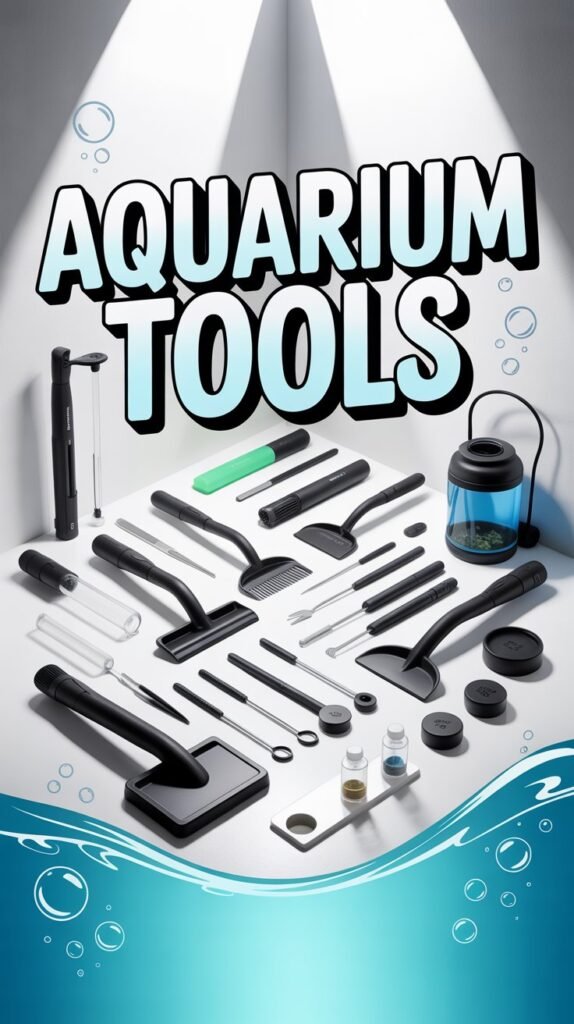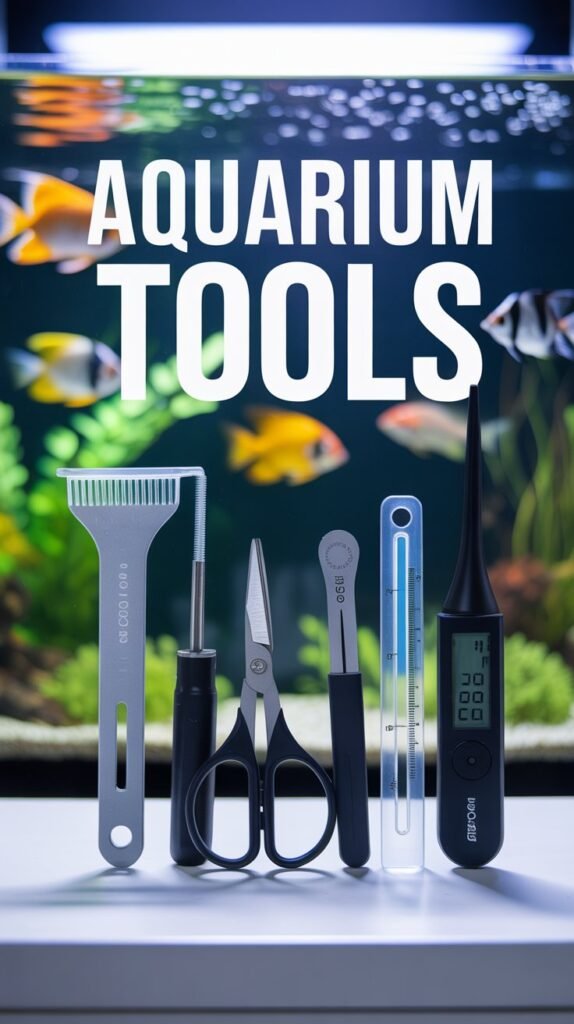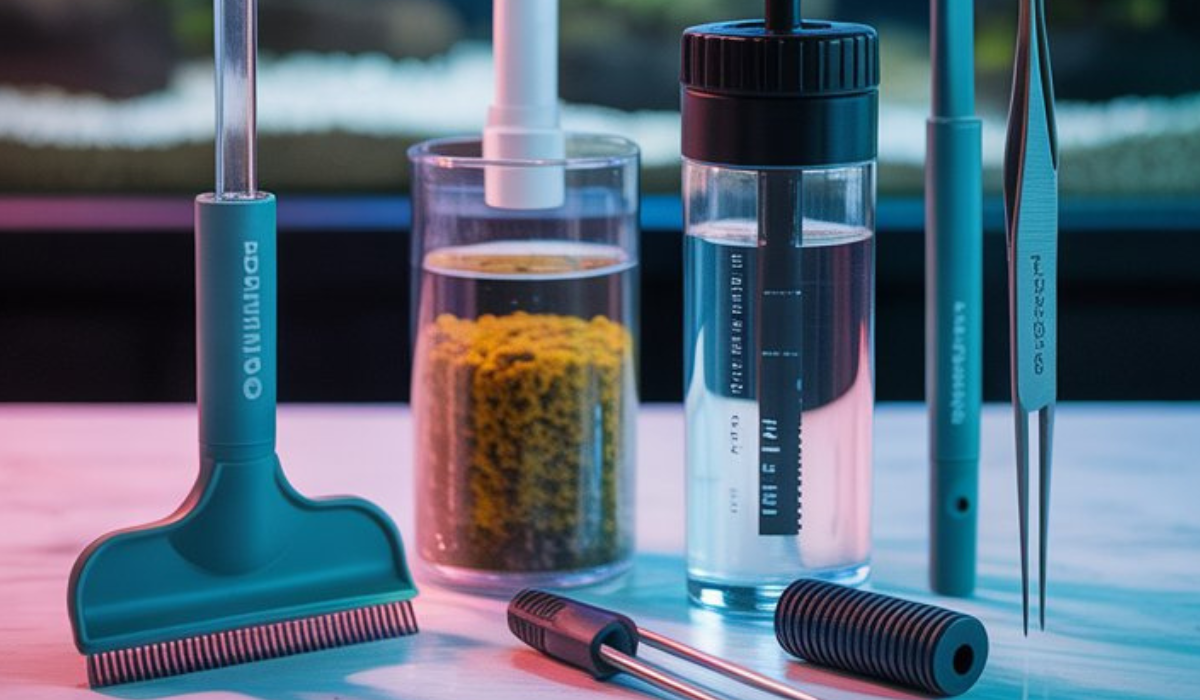Setting up and maintaining a beautiful aquarium is a rewarding experience, but it requires more than just water, fish, and plants. To keep your aquarium clean, healthy, and thriving, you need the right aquarium tools. These tools make daily care, maintenance, and aquascaping easier, ensuring that your fish enjoy a safe and stable environment.
In this comprehensive guide, we’ll explore everything about aquarium tools—their types, functions, benefits, and how to use them effectively. Whether you’re a beginner or an experienced aquarist, understanding these tools will help you achieve crystal-clear water, healthy fish, and a stunning aquascape.
What Are Aquarium Tools?
Aquarium tools are specialized instruments and equipment used to maintain, clean, and decorate fish tanks. They range from basic cleaning devices to advanced aquascaping instruments. These tools help manage water quality, remove debris, trim plants, and handle fish safely.
Without proper tools, routine aquarium maintenance can be messy, stressful, and less effective. The right tools simplify the process and help you maintain the delicate balance of your aquatic ecosystem.
Importance of Aquarium Tools

Having the right tools is essential for several reasons:
- Improves Water Quality: Tools like siphons, scrapers, and filters help keep water clean and toxin-free.
- Ensures Fish Health: Proper cleaning prevents ammonia, nitrite, and bacteria buildup.
- Simplifies Maintenance: Tools save time and effort, making regular upkeep easier.
- Supports Plant Growth: Aquascaping tools enable precise trimming and planting.
- Enhances Aesthetic Appeal: Clean glass, healthy plants, and balanced décor make your aquarium more attractive.
Without these tools, maintaining your aquarium’s beauty and health can become difficult and time-consuming.
Essential Aquarium Tools Every Hobbyist Should Own
Let’s go through the most important aquarium tools and their purposes.
1. Aquarium Net
An aquarium net is one of the most basic but necessary tools. It’s used to catch and transfer fish safely without causing stress or injury.
Features:
- Made of soft mesh material
- Available in various sizes
- Long handle for easy reach
Uses:
- Transferring fish during cleaning
- Removing debris, uneaten food, or dead fish
- Catching fry (baby fish)
Tip: Always use separate nets for different tanks to prevent cross-contamination.
2. Algae Scraper or Magnetic Cleaner
Algae can quickly grow on aquarium glass, making it look cloudy. Algae scrapers or magnetic cleaners are essential for removing algae buildup.
Types:
- Manual Scrapers: Use a blade or pad to remove algae manually.
- Magnetic Cleaners: Use magnets to clean glass from the outside.
Benefits:
- Keeps aquarium glass crystal clear
- Prevents light blockage
- Safe for glass and acrylic tanks
Tip: Use a razor blade scraper carefully on glass tanks and avoid using it on acrylic, which can scratch easily.
3. Aquarium Gravel Vacuum or Siphon
A gravel vacuum (also known as a siphon) helps clean the substrate and remove debris during water changes.
How It Works:
The siphon creates suction to remove dirty water and waste from the gravel without disturbing your fish or plants.
Benefits:
- Removes fish waste, uneaten food, and debris
- Helps with partial water changes
- Keeps substrate oxygenated and clean
Tip: Perform a 20–30% water change weekly using a gravel vacuum to maintain water quality.
4. Aquarium Tweezers and Scissors (Aquascaping Tools)
For aquascaping enthusiasts, tweezers and scissors are indispensable. They allow you to plant, trim, and arrange aquatic plants precisely.
Types of Tools:
- Straight Tweezers: For general planting and placing decorations.
- Curved Tweezers: For delicate areas or corners.
- Straight Scissors: Ideal for trimming tall plants.
- Curved Scissors: Help create natural curves in plant layouts.
Benefits:
- Promotes healthy plant growth
- Prevents overgrown plants from blocking light
- Helps create a neat, professional look
Tip: Always clean and dry your aquascaping tools after each use to prevent rust.
5. Aquarium Water Test Kit

Water quality is the foundation of a healthy aquarium. A water test kit allows you to measure critical parameters like:
- Ammonia
- Nitrite
- Nitrate
- pH
- KH (carbonate hardness)
- GH (general hardness)
Benefits:
- Detects early water quality issues
- Prevents fish stress or disease
- Ensures balanced water chemistry
Tip: Test your aquarium water at least once a week and after any changes to ensure stability.
6. Aquarium Heater and Thermometer
Most aquarium fish, especially tropical species, require stable water temperatures.
Aquarium Heater: Maintains a constant temperature suited to your fish species.
Thermometer: Monitors temperature to prevent sudden fluctuations.
Benefits:
- Prevents temperature shock
- Supports metabolism and immune system of fish
- Essential for tropical fish species
Tip: Place your heater near water flow from the filter to ensure even heat distribution.
7. Aquarium Filter Brush and Cleaning Tools
Filters are vital for removing toxins, but they can become clogged over time. Filter brushes help clean filter tubes and parts efficiently.
Benefits:
- Keeps filtration system working effectively
- Prevents buildup of algae and sludge
- Extends filter lifespan
Tip: Use tank water to rinse filter media instead of tap water, which can kill beneficial bacteria.
8. Water Conditioner and Dechlorinator Tools
Tap water often contains chlorine and chloramine, which are harmful to fish. A water conditioner is a chemical tool used to neutralize these substances.
Benefits:
- Makes tap water safe for fish
- Protects gills and scales
- Can detoxify heavy metals and ammonia
Tip: Always treat tap water before adding it to your aquarium during water changes.
9. Aquarium Tongs and Grippers

These tools are useful for rearranging decorations, removing objects, or handling plants in deep tanks without getting your hands wet.
Benefits:
- Prevents contamination from hands
- Safely moves items without disturbing fish
- Great for tanks with aggressive or shy species
Tip: Choose stainless steel or plastic tongs designed for aquarium use.
10. Fish Catcher Box or Breeder Box
These boxes are used for isolating sick fish, breeding, or protecting fry.
Benefits:
- Prevents aggression from other fish
- Provides a safe space for babies to grow
- Useful for observation and treatment
Tip: Ensure proper water flow in the breeder box to maintain oxygen levels.
11. Aquarium Lighting Tools
Proper lighting is crucial for both aesthetics and plant growth.
Types:
- LED Lights: Energy-efficient and customizable.
- Fluorescent Lights: Common in planted tanks.
Benefits:
- Enhances fish coloration
- Promotes photosynthesis in plants
- Simulates day and night cycles
Tip: Use a timer to provide 8–10 hours of light daily and prevent algae overgrowth.
12. Aquarium Water Changer and Hose Connector
A water changer makes water changes easier by connecting directly to a faucet. It drains old water and refills the tank with clean water efficiently.
Benefits:
- Saves time during maintenance
- Reduces stress on fish
- Minimizes spills and mess
Tip: Always treat the new water with a conditioner before refilling the tank.
13. Aquarium Brushes and Cleaning Pads
These are used to scrub algae and dirt from decorations, rocks, and tank surfaces.
Benefits:
- Keeps tank surfaces spotless
- Prevents buildup of unwanted algae
- Enhances tank appearance
Tip: Use separate brushes for decorations and glass to avoid scratches.
14. Air Pump and Air Stone
Air pumps and air stones are essential for increasing oxygen levels in the aquarium.
How They Work:
Air pumps push air through tubing to air stones, creating bubbles that enhance water circulation and oxygen exchange.
Benefits:
- Improves oxygen levels
- Prevents stagnant water
- Enhances visual appeal with bubbles
Tip: Use a check valve to prevent water from backflowing into the pump.
15. Aquarium Buckets and Containers
Buckets are often overlooked but are vital for water changes, cleaning, and transporting fish.
Benefits:
- Prevents contamination between tanks
- Easy for mixing saltwater or dechlorinated water
- Safe for temporary fish holding
Tip: Use aquarium-dedicated buckets only—never those that have contained chemicals.
16. Aquarium Gloves
Protect your hands and your fish by using aquarium-safe gloves.
Benefits:
- Prevents contamination from skin oils
- Protects against bites and scratches
- Keeps hands dry during maintenance
Tip: Always rinse gloves with dechlorinated water before and after use.
17. Digital Timer and Smart Controls
Automation tools like timers and smart controllers simplify daily routines.
Benefits:
- Automatically controls lighting schedules
- Maintains consistent environment
- Reduces manual workload
Tip: Smart controllers can also monitor temperature, pH, and lighting remotely.
18. Aquarium CO₂ System (for Planted Tanks)
For heavily planted aquariums, a CO₂ system is an advanced tool that boosts plant growth and coloration.
Benefits:
- Promotes lush, vibrant plant growth
- Prevents algae overgrowth by balancing nutrients
- Enhances aquascape aesthetics
Tip: Use a CO₂ diffuser and monitor CO₂ levels to avoid harming fish.
Choosing the Right Aquarium Tools
When selecting aquarium tools, consider:
- Tank Size: Larger tanks may require bigger tools or stronger equipment.
- Fish Type: Tropical, saltwater, and freshwater species have different needs.
- Aquascape Style: Heavily planted tanks require precision tools like scissors and tweezers.
- Budget: Invest in durable, rust-resistant tools for long-term use.
- Material: Stainless steel tools are ideal for durability and resistance to corrosion.
Maintenance Tips for Aquarium Tools
To ensure your tools last long and remain safe for your fish, follow these care tips:
- Rinse tools after every use with aquarium water.
- Dry them completely to prevent rust.
- Store tools in a clean, dry area.
- Avoid cross-use between tanks to prevent disease spread.
- Disinfect tools occasionally using mild aquarium-safe solutions.
Benefits of Using Proper Aquarium Tools
- Efficiency: Saves time during maintenance.
- Safety: Reduces stress and injury risk for fish.
- Precision: Ensures clean, professional aquascaping.
- Longevity: Keeps your tank healthy and reduces costly problems.
Common Mistakes to Avoid
- Using kitchen or household tools in aquariums.
- Neglecting regular tool cleaning.
- Using rough scrubbers that scratch glass.
- Over-cleaning filters and removing beneficial bacteria.
- Ignoring safety gear like gloves or check valves.
Conclusion
Owning the right set of aquarium tools is the secret to a successful, low-stress fishkeeping experience. From cleaning to aquascaping and maintenance, every tool serves a vital purpose in keeping your aquarium beautiful and balanced.
Whether you’re just starting or managing multiple tanks, investing in high-quality aquarium tools saves you time, protects your fish, and enhances the overall look of your aquatic environment.
Remember, a well-maintained tank is not only healthier but also more enjoyable to watch. Keep your tools clean, organized, and ready, and your aquarium will reward you with vibrant life and crystal-clear beauty.
FAQs About Aquarium Tools
1. What are the most essential aquarium tools for beginners?
Beginners should start with basic tools like a fish net, algae scraper, gravel vacuum, water conditioner, and thermometer. These cover cleaning, safety, and water management.
2. How often should I clean my aquarium tools?
Clean tools after every use and disinfect them monthly to prevent bacteria buildup and cross-contamination.
3. Are stainless steel aquascaping tools safe for aquariums?
Yes, stainless steel tools are safe, rust-resistant, and ideal for precision aquascaping. Just dry them thoroughly after use.
4. Do I need different tools for freshwater and saltwater tanks?
Some tools are universal, but saltwater tanks may need corrosion-resistant tools and extra equipment like hydrometers and protein skimmers.
5. Can I use household cleaning brushes or sponges in my aquarium?
No, many household cleaning products contain chemicals that can harm fish. Always use aquarium-safe brushes and pads.
6. How can I prevent algae from building up on the glass?
Regularly clean the glass with an algae scraper and manage light duration to prevent excessive algae growth.
7. What’s the best way to test my aquarium water?
Use a liquid or digital aquarium test kit to measure ammonia, nitrite, nitrate, and pH levels weekly.
8. Do I need an air pump in my aquarium?
While not always necessary, air pumps improve oxygen levels and are beneficial for heavily stocked tanks or warm environments.
9. Can I automate aquarium maintenance?
Yes, smart timers, automatic feeders, and CO₂ regulators can simplify daily tasks, keeping your aquarium stable and consistent.
10. Why are aquarium tools important for fish health?
Clean tools help maintain water quality, prevent disease, and create a stress-free environment for your fish.
Final Tip:
Building your collection of aquarium tools is an investment in your hobby. With the right equipment, you’ll enjoy a cleaner tank, healthier fish, and a more stunning aquascape—all with less effort and more satisfaction.

